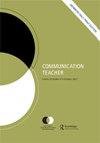The politics of social media: Utilizing political candidates’ Instagram posts to teach political argumentation and visual argument analysis
IF 0.4
Q4 COMMUNICATION
引用次数: 0
Abstract
Analysis of political and visual arguments is a key exercise traditionally included in undergraduate argumentation courses. This activity teaches students how to identify and analyze political candidate arguments presented on visual social media platforms, demonstrating how argumentation theory applies to social media campaigns. In the exercise, students identify an active political candidate’s Instagram account and select a recent post for analysis, focusing primarily on evaluating the visual arguments created within the post. After the analysis, students present their findings to the class, including evidence of the most compelling visual arguments identified. This activity incorporates the use of a familiar visual medium to help students connect wargumentation theories and concepts with relevant social media messages they may encounter in their daily lives. It also capitalizes on students’ existing use of popular visual social media to introduce basic argumentation theory, political communication practices, and visual argument analysis techniques. Courses This single-class activity is useful in undergraduate communication courses related to argumentation, political communication, and social media messaging. Relevant courses can include argumentation and advocacy, political argumentation, or visual argument analysis units of any course. For example, this activity can be successfully deployed in an Introduction to Political Communication course’s unit on the use of visual media during political campaigns. Objectives The learning objectives of this activity are: (1) to analyze visual arguments as they appear on social media and (2) to identify specific elements of strong and weak political arguments on a visually dominant social media platform.社交媒体的政治:利用政治候选人的Instagram帖子来教授政治论证和视觉论证分析
分析政治和视觉论据是传统上包括在本科辩论课程的关键练习。这个活动教学生如何识别和分析在视觉社交媒体平台上呈现的政治候选人的论点,展示论证理论如何应用于社交媒体活动。在练习中,学生们识别一个活跃的政治候选人的Instagram账户,并选择一个最近的帖子进行分析,主要集中在评估帖子中创建的视觉论点。在分析之后,学生们向全班展示他们的发现,包括最具说服力的视觉论据的证据。这个活动结合了使用熟悉的视觉媒介,帮助学生将战争理论和概念与他们在日常生活中可能遇到的相关社交媒体信息联系起来。它还利用学生对流行的视觉社交媒体的现有使用,介绍基本的论证理论,政治传播实践和视觉论证分析技术。这个单节课的活动在与辩论、政治传播和社交媒体信息相关的本科传播课程中很有用。相关课程可以包括论证与倡导、政治论证或任何课程的视觉论证分析单元。例如,这项活动可以成功地部署在政治传播导论课程的单元中,该单元是关于在政治竞选期间使用视觉媒体的。本活动的学习目标是:(1)分析社交媒体上出现的视觉论点;(2)在视觉上占主导地位的社交媒体平台上识别强弱政治论点的具体元素。
本文章由计算机程序翻译,如有差异,请以英文原文为准。
求助全文
约1分钟内获得全文
求助全文

 求助内容:
求助内容: 应助结果提醒方式:
应助结果提醒方式:


